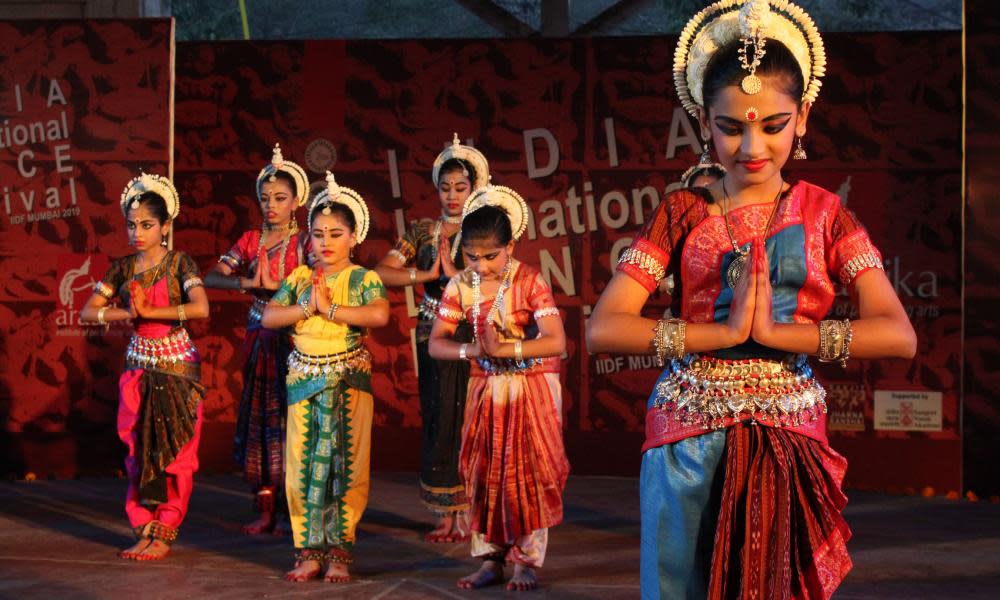Indian dance classes on Zoom lifted the heaviness I’d been carrying

In February, I learned that musician Kedaar Kumar, son of my long-ago Indian classical dance teacher, Rathna Kumar, had died suddenly of heart failure at 38. My heart sank. I reached out to Rathna Auntie with condolences. I had also wanted to send her a copy of my memoir, This Is One Way to Dance, which would be published in June; dance had played an important role in my life and I included her in my acknowledgments.
Related: Glue and scissors: how I rediscovered my teenage hobby amid the pandemic
Our reconnection was fortuitous; two months later I found myself studying with her once again, after three decades – this time on Zoom. It was the antidote to pandemic grief I hadn’t known I needed.
In the 1980s, an article about Rathna Kumar, a Houston-based professional dancer, appeared in India Abroad. She was our local teacher’s childhood friend from Chennai, and she visited Rochester, New York, during our school breaks, offering advanced workshops. We spent hours learning Bharatanatyam, Kuchipudi, and Mohiniyattam dances, interspersed with stories of Rathna Auntie’s sons and husband, and tales of Shiva and Parvati, Krishna and Radha, from Hindu mythology. Four of us had arangetrams, solo classical dance debuts, in which the guru presents the pupil to the community. I had not seen Rathna Auntie since mine, 30 years ago.
Dance is a kind of prayer, a way to celebrate and move through something, and also to mourn.
Rathna Auntie needed to keep dancing through her grief. In April, she added me to a WhatsApp group named “Vintage Kuchipudi Divas”. We, the “divas”, are in our 40s and 50s. A few are my childhood friends; a few I had not met. But now we have danced and talked and laughed together, remotely, several times on Wednesday evenings.
I had my own grief atop the pandemic: my father’s fast-growing cancer and chemo, evaporating events and a tour for a book that had taken 20 years to write. There was a day when everything was stuck. I was stuck. I grabbed my laptop and set up in our first floor living room in front of a mirrored purple tapestry from Chennai, and logged onto Rathna Auntie’s Zoom class. That evening, she was the same as ever, telling stories about her childhood, about her dance teacher, asking us questions, making us laugh, demonstrating sequences. Then, we danced.
A post shared by Sejal Shah (@sejalshahwrites) on May 21, 2020 at 7:36am PDT
Something about moving together so many years later transported me: a reunion, but each of us in different homes and time zones, kids crouching on couches in the background. I was 16 again, laughing and dancing, absorbed in duplicating her steps, mirroring her hand gestures. My Tamilian husband walked by. Rathna Auntie wanted to meet him. I am not South Indian, but their culture feels familiar, from years of listening to Carnatic music, dancing for Onam, hearing the lilting cadences of friends’ parents and Rathna Auntie speaking Telegu, Kannada, Tamil, Malayalam.
Dancing together lifted the heaviness I’d been carrying. Somehow, in the percussive, rhythmic footwork and pounding steps, the vigorous movement in our creaky bodies, a weight shifted. After Rathna Auntie’s class, I played music at midnight and turned the camera on myself. I danced. No makeup, my hair escaping a messy bun, I wore a kurta and shot two videos of me dancing to vintage songs: CeCe Peniston’s Finally and Suzanne Vega’s Left of Center – posting them later to Instagram. It was May and I hadn’t been able to dance in months. Sculpting my arms into tree branches, the motion loosened something in me. Bending my torso, stomping my feet, using more of my body than just my fingers and eyes, awoke parts of my brain that had been dormant. My videos garnered over 400 views; this surprised me. I felt happy dancing by myself and found a simple pleasure in sharing the dances. In comments, friends noted their own joy in witnessing my dancing.
Dancing with my guru again, 30 years after I last saw her, is an astonishing gift of the pandemic
Dancing with those women, something clicked. To hear Rathna Auntie, who had lost her son, not lose heart, but keep moving, even laughing. To connect! Dancing with my guru again, 30 years after I last saw her, is an astonishing gift of the pandemic. After hours disembodied before a blue-lit screen, I have to remind myself, we need to move more than fingers and eyes. We need community.
Rathna Auntie features this quote in the “about” section on her Facebook page: “Life is the dancer and you are the dance” – Eckhart Tolle, followed by her own words: “Dance is my raison d’etre, my greatest solace.” I appreciate that Rathna Auntie told us she needed to keep dancing while grieving. Sharing her dance with her students, she is still teaching us: here is a way to move through sorrow.
Sejal Shah is the author of This is One Way to Dance, essays on race, place and belonging (University of Georgia Press, 2020). She lives in Rochester, New York

